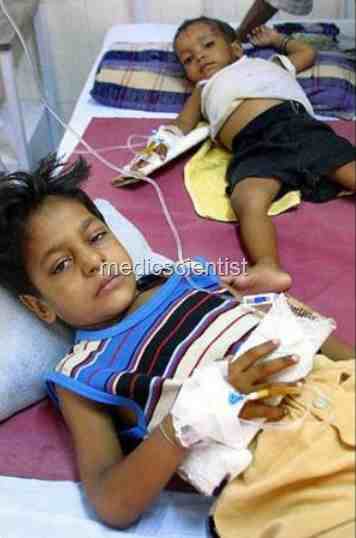Article Contents ::
- 1 All about Bacterial Infections BRUCELLOSIS and CHOLERA Caused by Gram–Negative Vibrio cholerae
- 2 EPIDEMIOLOGY Infections CHOLERA—
- 3 CLINICAL MANIFESTATIONS CHOLERA—
- 4 Cycle of Bacterial Infections CHOLERA Caused by Vibrio cholera
- 5 Infections CHOLERA Treatment
- 6 CLINICAL MANIFESTATIONS OF BRUCELLOSIS —
- 7 Treatment BRUCELLOSIS
All about Bacterial Infections BRUCELLOSIS and CHOLERA Caused by Gram–Negative Vibrio cholerae
- Gram–Negative Vibrio cholerae with diagnosis Treatment Signs and symptoms
An acute infection involving the entire small intestine, marked by profuse, watery, secretory diarrhea. Without treatment, the severe loss of fluids and electrolytes can cause dehydration and vascular collapse. The incubation period is from a few hours to 4 or 5 days
- Cholera results from infection with the enterotoxin-producing Gram-negative bacillus Vibrio cholerae which causes acute secretory diarrhoea.
EPIDEMIOLOGY Infections CHOLERA—
- The causative organism, Vibrio cholerae, is a short, curved, motile gram-negative rod.
- Individuals can reduce the risk of contracting cholera by avoiding possibly contaminated foodstuffs, good personal hygiene, and boiling or otherwise disinfecting drinking water
- Cholera is been endemic in the developing countries of Asia and Africa and has caused epidemics in Asia, the Middle East, South and Central America
- Two serotypes have been identified, 01 and 0139 (Bengal).
- The seventh pandemicbegan in 1961 in South East Asia, reached South America in January 1991, and still shows no sign of abating.
- The bacteria do not invade the bowel wall, but produce a potent enterotoxin that causes increased secretion of chloride, bicarbonate, and water into the small intestine, which overwhelms the large intestine’s ability to reabsorb.
 |
| Bacterial Infections CHOLERA Caused byGram–Negative Vibrio cholera |
- Vibrio cholerae and other bacteria of Genus Vibrio cause a number of infectious diseases.
CLINICAL MANIFESTATIONS CHOLERA—
- Approximately 80% of patients have mild disease marked by diarrhea and malaise.
- Most V. cholerae infections are asymptomatic, ranging from one case per 30 to 100 infections with the El Tor biotype to one case per two to four infections with the classical biotype
- Severe attacks are characterized by periodic voluminous “rice water” diarrhea, vomiting, and muscle cramps.
- The diarrhea in cholera may begin suddenly or gradually.
- Stools rapidly become watery with flecks of mucus, leading to their description as “rice water” stools since they have the appearance of water in which rice has been washed
- The Vibrio cholerae causes a diarrhoeal disease called cholera, which can result in rapid dehydration and death.
Cycle of Bacterial Infections CHOLERA Caused by Vibrio cholera
| cycle of Bacterial Infections CHOLERA |
- There is painless watery diarrhoea of sudden onset, resulting in hypovolemic shock and death.
- The stool is grey in colour, whitish fluid with mucous but no blood, like rice-water.
Infections CHOLERA Treatment
- The mainstay of treatment for cholera is the correction of hypovolemic dehydration.
- The degree of dehydration will determine the route, rate, and type of fluid used for volume replacement.
- Replacement of fluids, electrolytes and base. Fluids are given orally in large quantities.
- fluids maintenance is the most important in the treatment of cholera.
- Oral rehydration solutions (ORS) have reduced the mortality from cholera from over 50 to less than 1 percent
- The ORS or oral rehydration solution of WHO contains sodium, potassium, chloride, citrate and glucose.
- A home-made alternative of ORS is 1 teaspoon salt with 50 g rice + 40 g sucrose in 1 L drinking water + orange juice / coconut water for potassium.
- Ciprofloxacin or erythromycin for 3 days is antibiotic of choice.
Brucellosis (also called undulant, Mediterranean, or Malta fever) is a zoonotic infection with protean manifestations. A widespread infectious febrile disease affecting principally cattle, swine, and goats, and sometimes other animals and humans. It is caused by bacteria of several Brucella species.
- The microbiology and epidemiology of the organisms are discussed separately.
- The clinical manifestations, diagnosis, and treatment of brucellosis will be reviewed here.
| BRUCELLOSIS infection in humans |
- This is a bacterial infection transmitted to humans from infected animals especially swine (pig).
- There is fever of undulating pattern for weeks with musculoskeletal pain.
| BRUCELLOSIS different modes of infection |
- It is aiso called undulant fever. There may be septic arthritis of joints.
- There may be pneumonia, empyema, lung abscess etc.
CLINICAL MANIFESTATIONS OF BRUCELLOSIS —
- Patients tend to have a multitude of complaints, often without objective findings except fever.
- Brucellosis is a well-documented cause of fever of unknown origin with varied and nonspecific symptoms.
- A few cases of Brucella infection involving prosthetic devices, such as pacemaker wires or prosthetic joints, have been reported
Treatment BRUCELLOSIS
- In children and pregnant women tetracyclines should be avoided because they damage developing teeth and bones.
- In adult humans, treatment consists of combined tetracycline for 4 to 6 weeks and streptomycin for the first 2 weeks of the tetracycline therapy.
- Streptomycin
- Tetracyclines
- Ofloxacin
- or any broad spectrum antibiotics.

